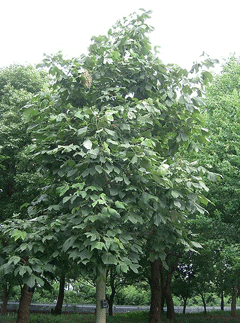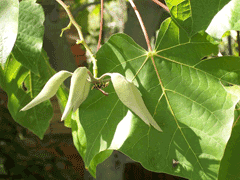 |
|
http://commons.wikimedia.org/wiki/User:KENPEI |
 |
| http://commons.wikimedia.org/wiki/User:Cillas |
Translate this page:
Summary
Bloom Color: White, Yellow.
Main Bloom Time: Early summer, Late summer, Mid summer. Form: Oval, Upright or erect.
Physical Characteristics

 Firmiana simplex is a deciduous Tree growing to 15 m (49ft) by 10 m (32ft) at a fast rate.
Firmiana simplex is a deciduous Tree growing to 15 m (49ft) by 10 m (32ft) at a fast rate.
See above for USDA hardiness. It is hardy to UK zone 9. It is in flower in July. The species is monoecious (individual flowers are either male or female, but both sexes can be found on the same plant).
Suitable for: light (sandy) and medium (loamy) soils. Suitable pH: mildly acid, neutral and basic (mildly alkaline) soils. It can grow in semi-shade (light woodland) or no shade. It prefers moist soil.
UK Hardiness Map
US Hardiness Map
Synonyms
F. platinifolia. Hibiscus simplex. Sterculia mariesii. S. platinifolia.
Plant Habitats
Woodland Garden Canopy; Secondary;
Edible Uses
Edible Parts: Seed
Edible Uses:
Seed - roasted[105, 177]. An oily texture[178].
References More on Edible Uses
Medicinal Uses
Plants For A Future can not take any responsibility for any adverse effects from the use of plants. Always seek advice from a professional before using a plant medicinally.
Antiphlogistic Astringent Expectorant Refrigerant Salve
Astringent, salve[178]. The seed is antiphlogistic, expectorant and refrigerant[218]. A decoction of the roots is used to reduce swellings[218]. A lotion of the leaves is used in the treatment of carbuncles, haemorrhoids and sores[218].
References More on Medicinal Uses
The Bookshop: Edible Plant Books
Our Latest books on Perennial Plants For Food Forests and Permaculture Gardens in paperback or digital formats.

Edible Tropical Plants
Food Forest Plants for Hotter Conditions: 250+ Plants For Tropical Food Forests & Permaculture Gardens.
More

Edible Temperate Plants
Plants for Your Food Forest: 500 Plants for Temperate Food Forests & Permaculture Gardens.
More

More Books
PFAF have eight books available in paperback and digital formats. Browse the shop for more information.
Shop Now
Other Uses
Fibre Hair Wood
A fibre is obtained by retting the bark[46, 61]. It is used for coarse cordage[109] and cloth[178]. A hair wash is made from the leaves and fibre[178]. Wood. Used for making furniture and coffins[46, 61, 178].
Special Uses
Carbon Farming
References More on Other Uses
Cultivation details
Industrial Crop: Fiber Industrial Crop: Gum Management: Standard Regional Crop
Landscape Uses:Pest tolerant, Pollard, Specimen. Prefers a good sandy loam[1]. Requires a well-drained but moisture-retentive fertile soil in full sun or light shade[188]. Plants are not very hardy in Britain, they succeed outdoors in the mildest parts of the country[11, 166], though they do not reach tree-size[188]. Trees cast a heavy shade[178]. Special Features:Not North American native, Naturalizing, Attractive flowers or blooms.
Carbon Farming
-
Industrial Crop: Fiber
Clothing, rugs, sheets, blankets etc. Currently, almost none of our fiber are produced from perennial crops but could be!
-
Industrial Crop: Gum
Used as thickeners and gelling agents. Non-destructively harvested gums come from tapped trees and seed.
-
Management: Standard
Plants grow to their standard height. Harvest fruit, seeds, or other products. Non-Destructive management systems.
-
Regional Crop
These crops have been domesticated and cultivated regionally but have not been adopted elsewhere and are typically not traded globally, Examples in this broad category include perennial cottons and many nuts and staple fruits.
References Carbon Farming Information and Carbon Sequestration Information
Temperature Converter
Type a value in the Celsius field to convert the value to Fahrenheit:
Fahrenheit:
The PFAF Bookshop
Plants For A Future have a number of books available in paperback and digital form. Book titles include Edible Plants, Edible Perennials, Edible Trees,Edible Shrubs, Woodland Gardening, and Temperate Food Forest Plants. Our new book is Food Forest Plants For Hotter Conditions (Tropical and Sub-Tropical).
Shop Now
Plant Propagation
Seed - best sown as soon as it is ripe in a warm greenhouse[200]. The stored seed can be sown in the early spring in a greenhouse[1] and usually germinates within 2 months[K]. When they are large enough to handle, prick the seedlings out into individual pots and grow them on in the greenhouse for at least their first winter. Plant them out into their permanent positions in late spring or early summer, after the last expected frosts. Consider giving the plants some protection from the cold for at least their first winter outdoors.
Other Names
If available other names are mentioned here
Native Range
TEMPERATE ASIA: China (Anhui Sheng, Fujian Sheng, Guangdong Sheng, Guangxi Zhuangzu Zizhiqu, Guizhou Sheng, Hainan Sheng, Hubei Sheng, Hunan Sheng, Jiangsu Sheng, Jiangxi Sheng, Shaanxi Sheng, Shandong Sheng, Shanxi Sheng, Sichuan Sheng, Yunnan Sheng, Zhejiang Sheng), Japan (Honshu (c. & w.), Kyushu, Ryukyu Islands, Shikoku), Taiwan
Weed Potential
Right plant wrong place. We are currently updating this section.
Please note that a plant may be invasive in one area but may not in your area so it's worth checking.
Conservation Status
IUCN Red List of Threatened Plants Status :

Growth: S = slow M = medium F = fast. Soil: L = light (sandy) M = medium H = heavy (clay). pH: A = acid N = neutral B = basic (alkaline). Shade: F = full shade S = semi-shade N = no shade. Moisture: D = dry M = Moist We = wet Wa = water.
Now available:
Food Forest Plants for Mediterranean Conditions
350+ Perennial Plants For Mediterranean and Drier Food Forests and Permaculture Gardens.
[Paperback and eBook]
This is the third in Plants For A Future's series of plant guides for food forests tailored to
specific climate zones. Following volumes on temperate and tropical ecosystems, this book focuses
on species suited to Mediterranean conditions—regions with hot, dry summers and cool, wet winters,
often facing the added challenge of climate change.
Read More
Expert comment
Author
(L.)W.Wight.
Botanical References
11109200
Links / References
For a list of references used on this page please go here
Readers comment